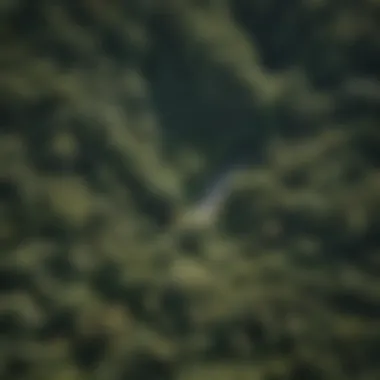Exploring Lidar Technology in Forest Management


Intro
In the age of advanced technology, the realm of forestry is experiencing a renaissance, driven by innovative tools and methods. Lidar, or Light Detection and Ranging, stands out as a transformative technology that captures the intricate details of woodland ecosystems. This section serves to outline the importance of understanding Lidar measurement and its diverse applications in forestry practices. By unraveling its principles, methodologies, and benefits, we set the stage for a deep dive into how Lidar contributes to sustainable forest management and conservation.
Understanding Woodland Ecosystems
The intricate dynamics of woodland ecosystems are vital, not just for the trees but for the myriad of species that call forests home. Grasping this complexity is essential to recognize how Lidar plays a role in enhancing our understanding and management of these ecosystems.
Importance of Biodiversity in Forests
Forests serve as a natural tapestry, rich in biodiversity. The variety of plant and animal life contributes significantly to ecological balance. Lidar helps forest professionals to map and analyze the structure and composition of woodlands, revealing habitat diversity. This technology enables the identification of key species, their distributions, and their interrelationships. Accurate biodiversity assessments lead to informed decision-making aimed at preserving vulnerable species and promoting overall ecosystem health.
Role of Forests in Climate Regulation
Forests are often called the lungs of our planet, and rightly so. They play a crucial role in sequestering carbon dioxide, thus regulating the Earth's climate. Lidar provides precise measurements of forest structure, such as canopy height and biomass, essential for calculating carbon stocks. By understanding how much carbon is stored in different forest types, we can better manage these ecosystems to mitigate climate change.
"Accurate Lidar measurements can capture the pulse of a forest, reflecting its health and resilience against climate challenges."
Sustainable Forestry Practices
Sustainable forestry practices are pivotal in balancing ecological health with human needs. Lidar technology facilitates this balance by providing detailed data that informs management strategies.
Principles of Sustainable Forestry
At the heart of sustainable forestry lies the principle of meeting present needs without compromising future generations. Lidar enhances the ability to monitor forest conditions, making it easier to assess and implement practices like selective logging, habitat conservation, and regeneration planning. With accuracy and detail, forest managers can make decisions that align with both ecological integrity and economic viability.
Case Studies of Successful Implementations
Numerous case studies illustrate successful Lidar integration in forestry. For instance, in a project conducted in the Pacific Northwest, Lidar was utilized to analyze old-growth forests, leading to effective habitat restoration strategies. The technology helped pinpoint areas most impacted by climate events, allowing for targeted interventions that preserved biodiversity.
Woodland Stewardship Techniques
Woodland stewardship is about nurturing forests through responsible management. Lidar is a tool that supports effective stewardship by providing critical data for planning and strategy formulation.
Forest Management Plans
Crafting a forest management plan involves understanding both the current state and future needs of a forest. Lidar data aids in developing these plans by providing a comprehensive overview of forest metrics, including tree height, density, and species composition. With this information, forestry professionals can devise strategies that encourage healthy ecosystems while also considering economic outcomes.
Conservation Strategies
In light of declining biodiversity and climate change, conservation strategies are more important than ever. Lidar technology provides insight into forest health, enabling targeted conservation efforts. By identifying areas of high ecological value, we can prioritize resources for protection and restoration efforts, ensuring that vital habitats remain intact for future generations.
Through these lenses of Lidar measurement's impact on forestry, we can appreciate the nuances of woodland ecosystems and the imperative of sustainable practices. The following sections will delve deeper into specific methodologies and benefits that Lidar brings to the fore, equipping forestry professionals and academics alike with the knowledge to harness this technology effectively.
Prologue to Lidar Technology
In recent years, Lidar technology has emerged as a game changer in the realm of forestry. It represents a leap forward in the way we understand and manage woodland ecosystems. This article aims to illuminate the significance of Lidar, detailing its principles, data collection techniques, and applications specifically tailored for forestry.
Definition of Lidar
Lidar, short for Light Detection and Ranging, is a remote sensing method that utilizes light in the form of a pulsed laser to measure distances to the Earth's surface. Unlike other methods, Lidar can penetrate through canopy cover, providing a detailed representation of terrain and vegetation structure. Essentially, it captures millions of data points, generating a three-dimensional map fine enough to reveal forest metrics like height, density, and biomass.
It operates by emitting laser pulses from a sensor, which then bounce back after hitting a surface. This process helps in creating what is called a point cloud, a term that refers to the collected data points that outline the terrain's contours. The beauty of Lidar lies not just in its precision but also in its ability to map large areas relatively quickly, making it invaluable for forestry operations and environmental monitoring.
Evolution of Lidar Systems
Lidar technology has come a long way since its inception. The journey began in the 1960s, when laser technology was still in its infancy. Initially, Lidar systems were primarily used for military applications and atmospheric research. However, as the applications for civilian usage grew, so did the capabilities of Lidar systems. By the 1990s, advancements in laser technology and computing power allowed for the creation of more sophisticated airborne and terrestrial Lidar systems.
Today's Lidar systems boast high resolution and accuracy, equipped with sensors that range from low-cost units suitable for small-scale applications to expensive, cutting-edge equipment able to operate at vast altitudes for national surveys. They can seamlessly combine with GPS and inertial measurement units (IMUs) to produce highly detailed spatial data. The evolution of Lidar is not just about technological advancements; it also reflects a growing recognition of the need for sustainable forest management and conservation efforts.
"In forestry, Lidar technology serves not just as a tool but as a lens that enhances our vision of natural ecosystems, guiding decision-making and fostering stewardship."
As we forge ahead, understanding how Lidar technology works and its historical context gives us a clearer picture of its essentiality in addressing today’s forestry challenges.
How Lidar Measures Terrain


When delving into the realm of forestry management, it's pivotal to understand how Lidar measures terrain. This section sheds light on the essential methodologies that underlie Lidar technology and its unique advantages. By grasping these foundational elements, forestry professionals can optimize their strategies for managing woodlands.
Basic Working Principles of Lidar
Lidar, short for Light Detection and Ranging, operates similarly to a bat's echolocation but employs lasers instead. The basic principle is quite straightforward: a Lidar system emits a rapid sequence of laser pulses towards the ground and then measures the time taken for these pulses to return after hitting an object or surface. This time delay translates into precise distance measurements, helping to create a detailed three-dimensional model of the terrain.
- Active Remote Sensing: Lidar stands out as an active remote sensing method, meaning it generates its own signal rather than passively relying on ambient light. This characteristic grants it the capability to function day or night, overcoming some challenges that traditional photogrammetry might face.
- Point Cloud Generation: The culmination of this data collection process results in a point cloud, which is a dense assembly of data points in three-dimensional space. Each point corresponds to a laser return, delivering a wealth of information about the terrain features.
"Lidar's ability to create highly detailed 3D maps allows forestry managers to visualize their plots like never before, dissecting complex canopy structures and ground topography."
- Laser Wavelengths: Different wavelengths employed in Lidar systems impact how well they penetrate through vegetation and how precise the measurements can be. For instance, near-infrared lasers can provide exceptional detail regarding vegetation height while also revealing hidden ground features.
The excitement doesn't stop at capturing the data; rather, it extends into the analysis and the multiple interpretations possible from a single set of measurements. With a sound understanding of Lidar's basic principles, forestry experts can effectively harness the technology for various applications, from measuring tree heights to assessing biomass.
Types of Lidar: Airborne vs. Terrestrial
When it comes to implementation in forestry, the choice between airborne and terrestrial Lidar can significantly sway the outcome of projects. Both have their merits, but understanding their differences is crucial.
- Airborne Lidar: This form is typically mounted on aircraft or drones. It’s commonly employed for large-scale topographic mapping. The higher altitude allows it to cover extensive areas quickly, making it ideal for forest inventory and landscape assessment. Airborne Lidar tends to collect data from a broader perspective, which significantly bolsters the capability to monitor extensive forest regions.
- Terrestrial Lidar: This type is ground-based and is often fixed on a tripod. It serves well for detailed investigations of smaller areas, such as individual tree health assessments or constructing intricate models of forest structures. Its precision in capturing fine details makes it the go-to choice for site-specific evaluations.
Both methods share a common thread in their reliance on laser technology, yet they diverge when it comes to operational contexts and resultant data. Adopting either will depend on the specific needs of a forestry project, budget constraints, and desired outcomes.
In sum, understanding how Lidar measures terrain opens the door to effective woodland management and enhances the decision-making process in forestry. Armed with this knowledge, professionals can tailor their approaches, ensuring that every square inch of woodland is mapped with precision.
Lidar Data Collection Process
Understanding the Lidar data collection process is like laying the groundwork for a solid house; you wouldn't want to start building without a strong foundation. This section dives into the significance of how Lidar captures terrain information, accentuating not just the methods, but also the various elements that come into play.
Lidar technology is pivotal in modern forestry management, mainly because it captures vast amounts of data quickly and accurately. This process entails careful preparation, specific techniques for data collection, and an understanding of the surrounding environments that impact the results.
Preparation and Planning
The preparatory phase is crucial for a successful Lidar survey. Think of it as organizing a family road trip; if you don’t map out the route and check the weather, you might end up lost or in a storm. In this context, preparation involves several steps:
- Site Assessment: Analyzing the characteristics of the site where data will be collected helps in understanding the terrain's geography, plant cover, and potential obstacles.
- Defining Objectives: It’s paramount to set clear goals for what you aim to achieve with the Lidar data. Are you estimating biomass? Monitoring health? Different objectives might dictate different approaches.
- Logistics: This includes ensuring the necessary equipment is ready, understanding regulatory permissions, and mitigating risks associated with weather conditions and terrain.
Careful planning can enhance data quality and ensure the collected data fits seamlessly into analytical frameworks.
Data Acquisition Techniques
Once the groundwork is set, it’s time to roll up the sleeves and dive into data acquisition techniques. Various methods cater to different needs, making it essential to choose wisely. Here are some common techniques employed:
- Airborne Lidar Systems: Using aircraft equipped with lasers, this technique captures a wide area in a short time. This is particularly useful for extensive forests where ground access might be challenging.
- Terrestrial Lidar Systems: These systems are typically ground-based and utilized for more localized surveys. They provide high-resolution data and are excellent for detailed assessments of specific areas or trees.
- Mobile Lidar: With a vehicle-mounted system, this technique facilitates dynamic collection as the vehicle moves through the environment. It’s useful for preliminary assessments and can gather information quickly over varying terrains.
"The right acquisition technique not only affects the quality of data but also influences the outcomes of forest management strategies."
Selecting the best method hinges on the goals established in the planning phase and the specific environmental conditions of the target area.
In summary, the Lidar data collection process is multi-faceted, encompassing rigorous preparation and varied techniques. This meticulous approach ensures that the vast potential of Lidar technology is harnessed effectively. By refining these processes, forestry professionals can significantly enhance the effectiveness of woodland management and conservation strategies.
Data Processing and Analysis
In the world of Lidar measurement, data processing and analysis serve as the backbone, transforming raw data into actionable insights. Without a proper understanding of how data is processed, the splendid measurements obtained from the forest canopy can easily miss the mark. This section emphasizes the importance of data processing in maximizing the utility of Lidar data, highlighting specific elements, benefits, and various considerations that professionals in forestry must keep in mind.
Point Cloud Generation
The heart of Lidar's output is the point cloud, a collection of data points representing the 3D form of the scanned environment. Each point in this cloud corresponds to a laser pulse that bounces back after hitting an object, such as trees or terrain. The process of generating point clouds is crucial because it provides the foundational data for further analysis.
The generation of point clouds involves several steps:
- Data Filtering: To ensure accuracy, it's fundamental to filter out noise or extraneous points created by environmental factors or unwanted objects.
- Georeferencing: Each point must be placed accurately in a 3D space, which requires precise geographic coordinates. This is key for applications like forest mapping and terrain modeling.
- Classification: Once the point cloud is generated, it undergoes classification to identify different elements, such as vegetation, ground surface, and structures. This categorization aids in deriving meaningful metrics, like canopy height and vegetation density.
The quality of the point cloud generated directly impacts the subsequent analysis and consequently the decisions made in environmental management. This emphasizes the importance of employing robust algorithms and high-quality sensors during data collection.
Software Tools for Lidar Analysis
After generating the point cloud, the next step is analysis, heavily reliant on sophisticated software tools. Various applications exist, each offering different functionalities tailored towards specific needs in forestry. Choosing the right software can greatly enhance the quality of insights derived from Lidar data.


Some of the commonly used software tools include:
- LAStools: Known for its efficiency in processing large Lidar datasets, tools from LAStools can handle everything from classification to visualization.
- ArcGIS: A well-established platform in the GIS field, ArcGIS offers extensive tools for integrating Lidar data with additional geographic layers, providing a rich context for analysis.
- QGIS: An open-source alternative, QGIS allows users to manipulate geospatial data and has various plugins for Lidar analysis.
Key considerations when selecting software:
- Compatibility: Ensure that your chosen software can handle your data formats.
- User Support & Community: Active user communities can provide essential support.
- Training Resources: Availability of tutorials and documentation can expedite the learning process.
"Effective Lidar analysis hinges on the choice of software tools, with each tool offering unique capabilities to elevate data interpretation."
The integration of data processing and analysis remains a critical factor in transforming raw Lidar data into useful forestry insights. As technology evolves, the capabilities and efficiencies of these processes continue to improve, heralding exciting advancements in woodland management and biodiversity monitoring.
Applications of Lidar in Forestry
The utilization of Lidar technology in forestry is becoming essential. It enhances the precision and efficiency of forest management practices. This section discusses several key applications of Lidar that significantly contribute to improving both the knowledge and sustainability of forest ecosystems. The advantages it brings to forest inventory, habitat assessment, and health monitoring are monumental, while also having some challenges that need attention.
Forest Inventory and Biomass Estimation
One of the most pivotal applications of Lidar in forestry is its role in forest inventory and biomass estimation. Traditional methods for surveying forests, often labor-intensive and time-consuming, face numerous challenges, such as accessibility and variability in tree density. Lidar dramatically refines this process.
With Lidar’s ability to capture detailed three-dimensional data, forest managers can efficiently assess the volume and biomass of trees across vast areas.
- The laser pulses emitted from a Lidar system bounce off the tree canopies and ground surfaces, providing a wealth of information about forest structure.
- By analyzing the point clouds generated, professionals can determine attributes such as tree height, canopy cover, and even species classification.
- This data can be utilized to create accurate estimates of biomass and carbon stocks, playing a crucial role in sustainability efforts and carbon accounting.
"Lidar not only improves the accuracy of forest inventories but also helps in strategizing management plans that are based on solid data."
Habitat Assessment and Biodiversity Monitoring
Lidar also plays a significant role in habitat assessment and monitoring biodiversity. As conservation efforts gain prominence, understanding the intricate relationships within forest ecosystems becomes crucial. Lidar technology facilitates detailed analysis of forest structures that support diverse wildlife habitats.
- Different tree heights, densities, and canopy characteristics directly influence the habitat suitability for various species.
- Using Lidar data, forestry professionals can map these attributes, leading to a better understanding of how habitats are utilized by fauna.
- Additionally, monitoring changes over time, particularly in response to environmental factors or management practices, provides invaluable insights into habitat dynamics.
Forest Health Monitoring
Another critical application of Lidar is in forest health monitoring. Detecting and managing forest health issues—such as disease, pests, and climatic impacts—requires precise and timely data. Lidar technology provides that edge.
- Through high-resolution data, changes in forest structure and productivity can be monitored effectively. For instance, a decline in tree height or increased gaps in canopy cover can indicate underlying health issues.
- Furthermore, Lidar can help assess the impact of wildfires, enabling a better understanding of the areas affected and guiding reforestation efforts.
- Continuous monitoring allows for early intervention strategies to help mitigate or reverse damage caused by external pressures.
Epilogue
The applications of Lidar in forestry are abundant and continue to demonstrate their importance through various facets of woodland stewardship. From precise inventory methods to detailed habitat assessments and rigorous health monitoring, professionals can leverage the data provided by Lidar to make informed decisions and push for more sustainable forestry practices.
Case Studies in Lidar Usage
Lidar, or Light Detection and Ranging, has transformed the landscape of forestry management, bringing forth new methodologies that enhance traditional practices. Exploring case studies in Lidar usage is essential to grasp its practical applications and effectiveness in real-world forestry scenarios. These studies illustrate the myriad ways Lidar can be employed, demonstrating both its benefits and the hurdles practitioners may face. Moreover, they spotlight the innovative thought processes behind adopting technology in managing forest resources sustainably.
Successful Lidar Implementations in Forest Management
As forest management increasingly encounters challenges like climate change and biodiversity loss, successful Lidar implementations have emerged as beacons of hope. One compelling example comes from the United States Forest Service, where Lidar was utilized in the Pacific Northwest to assess forest stand heights and biomass. This project not only improved data collection efficiency but also produced outcomes that resonated with both environmental standards and financial expectations.
- Detailing the process: They employed an airborne Lidar system to capture data over vast forest areas. The information gathered allowed for the mapping of tree heights, crown dimensions, and ground topography, providing insights into forest structure and health.
- Key outcomes: The study revealed notable improvements in the accuracy of forest inventory assessments compared to traditional methods, thereby enabling better decision-making and resource allocation. This increase in accuracy led to enhanced ecological restoration projects in severely logged areas.
Another striking case is from Germany, where Lidar technology was adopted in a national park to monitor forest change over time. Health assessments revealed that certain areas were under stress due to pest infestations exacerbated by climate change, allowing for timely interventions to protect the forest ecosystem.
Comparative Studies: Lidar vs. Traditional Methods
Understanding how Lidar stacks up against traditional methods is crucial for forestry professionals considering its adoption. Recent comparative studies highlight both advantages and drawbacks. Traditional methods often rely on manual surveying techniques, which can be time-consuming and prone to human error. In contrast, Lidar offers automation and precision that traditional techniques fail to match.
- Advantages of Lidar:
- Time Efficiency: Collecting vast amounts of data over large areas in a fraction of the time traditional methods require.
- Increased Precision: Data obtained through Lidar reduces the subjective bias present in manual assessments.
- Comprehensive Coverage: Lidar can penetrate through tree canopies, revealing hidden ground conditions that are oftentimes invisible using conventional methods.
Conversely, a drawback to Lidar noted in some studies is its higher initial investment and operational costs, which can be a barrier to entry for smaller operations. This cost can be mitigated in the long run through efficiency gains and more accurate data-driven decisions.
A case in point would be a study conducted in a temperate forest in Canada comparing Lidar-derived biomass estimations with traditional sampling methods. Results indicated that Lidar assessments could achieve biomass estimations with a margin of error 15% lower than those generated from manual methods, emphasizing not just accuracy but also the ecological implications of proper forest management.


"Innovative applications of Lidar in forestry offer a glimpse into a future where technology and nature coexist sustainably."
In summary, through these case studies and comparative analyses, Lidar's value in forestry becomes apparent, not just as a tool but as a game-changing approach to forest management that invites a rethinking of conventional practices.
Future of Lidar Technology in Forestry
The forest management landscape is changing rapidly, and Lidar technology is at the forefront of this evolution. The future of Lidar in forestry holds immense potential for improving precision in measurement, enhancing data utilization, and fostering sustainable practices. As environments become more complex, the ability to capture and analyze forest data accurately is increasingly critical.
Innovations in Lidar Capabilities
Lidar technology is not static; it is undergoing continuous innovation. The advancements are not just upgrades but are reshaping how forestry professionals approach their work. For instance, new developments in multi-spectral Lidar are allowing for the assessment of tree health and species identification. This means that instead of only mapping terrain or canopy heights, foresters can now gather data that provides insights into tree conditions, which is vital for making informed management decisions.
Moreover, the emergence of unmanned aerial vehicles (UAVs) equipped with Lidar sensors is making data collection more accessible, especially in hard-to-reach areas. This technology enables a more comprehensive forest inventory, allowing professionals to collect vast amounts of data without extensive ground surveys.
Benefits of these innovations include:
- Increased efficiency: UAVs can cover large areas far quicker than traditional methods.
- Cost-effectiveness: Reduced need for labor-intensive surveys can lower operational costs.
- Rich data sets: Advanced sensors capture multiple wavelengths, thus providing better insights into biodiversity and ecosystem health.
Integrating Lidar with Other Technologies
The synergy created by combining Lidar with other technologies is where the true magic lies. For instance, integrating Lidar data with Geographic Information Systems (GIS) allows for a holistic view of forest management. By layering data attributes—such as soil types, vegetation species, and historical land use—foresters can make micro-level decisions that ensure the sustainability of forest resources. GIS also facilitates precision mapping, enabling better planning for timber harvesting or conservation efforts.
Another promising combination is Lidar with machine learning algorithms, particularly for analysis and predictive modeling. With the power of artificial intelligence, foresters can predict changes in forest dynamics based on current data trends, leading to proactive rather than reactive management approaches.
Integrating these technologies brings several advantages:
- Enhanced analytical capabilities: Identify patterns and anomalies that may not be evident through traditional methods.
- Improved decision-making: Insights derived from integrated data can influence quicker, more informed choices.
- Adaptability: The ability to integrate means that as technology evolves, forestry practices can adapt seamlessly.
Lidar technology's future in forestry is not just about collecting data; it’s about transforming that data into actionable insights.
Challenges and Limitations of Lidar in Forestry
Lidar technology is reshaping how forestry professionals approach the management and conservation of wooded areas. However, while the benefits are manifold, it is crucial to also recognize the challenges and limitations involved. Understanding these constraints can lead users to make better-informed decisions when utilizing Lidar in various forestry applications. In this section, we will specifically explore environmental factors that impact accuracy and the issues related to cost and accessibility.
Environmental Factors Impacting Accuracy
Lidar technology, much like many other advanced systems, faces obstacles that jeopardize its effectiveness in certain contexts. Various environmental factors can significantly impact the accuracy of Lidar measurements. These factors include:
- Canopy Cover: Dense forest canopies can obstruct Lidar beams from reaching the ground, potentially leading to underestimations in height and biomass. Trees with overlapping branches act as barriers, creating blind spots that distort data collected.
- Terrain Variability: Areas with steep slopes or rugged terrains can complicate Lidar data collection. The inclination may cause the laser beams to reflect unpredictably off surfaces, leading to inaccuracies in datasets.
- Atmospheric Conditions: Weather plays a significant role too. Fog, rain, or heavy snow can impede the laser signals, muddling the precision of the measurements. A clear day is ideal for obtaining clean, high-resolution data, but these conditions are not always available.
Understanding these environmental limitations is vital for forestry professionals when planning Lidar data collection. Adjustments in methodology, like timing and operational strategies, can enhance data reliability.
Cost and Accessibility Issues
Despite the impressive capabilities of Lidar technology, two significant obstacles remain prevalent: cost and accessibility.
- Initial Setup Costs: Deploying Lidar can require substantial financial investment. The purchase of equipment, software, and the need for skilled personnel to operate systems drives up initial costs. Not everyone within the forestry sector has the budget to invest in expensive technology.
- Maintenance and Upgrades: Beyond the initial expense, maintenance and equipment upgrades can add to the financial burden. Technology evolves quickly, and keeping pace with the latest advancements means ongoing investments.
- Training and Expertise Requirements: More so than just hardware, employing Lidar effectively necessitates skilled professionals. This requirement can hinge on the availability of training programs and resources. In some regions, the knowledgebase for Lidar operations may be sparse, complicating its integration into current practices.
Accessibility barriers can create uneven opportunities in the forestry sector, disproportionately affecting smaller operations. These challenges underline the need for a strategic approach when considering Lidar as a tool in forestry management.
“Understanding Lidar's limitations can foster smarter data collection strategies and more effective forest stewardship.”
End
In reflecting on the role of Lidar technology in forestry, it becomes clear that the advantages it offers are significant and multifaceted. This article has traversed the intricate pathways that Lidar measurement technology opens up for professionals dedicated to woodland management and conservation. The primary takeaway is the immense potential that Lidar has to enhance the understanding and stewardship of forest ecosystems.
Recap of Lidar Benefits in Forestry
Lidar is not just a flashy piece of technology; it delivers tangible benefits that can transform forestry practices. To sum it up:
- Precision in Data Collection: Lidar provides highly accurate data, which is invaluable in inventory assessments and biomass calculations. It allows for the measurement of forest parameters that are often difficult to assess using traditional methods.
- Cost-Effectiveness: Despite the upfront investment, Lidar can actually save money in the long run. The data it generates cuts down on wasted time and resources during both planning and execution phases of forestry projects.
- Enhanced Monitoring Capabilities: Lidar excels in offering insights into forest health which can lead to improved management practices. This technology helps to swiftly identify changes in forest structure and allows for proactive measures instead of reactive responses.
Lidar technology reshapes our approach to understanding woodland dynamics, making it an essential tool for today’s forestry professionals.
Encouragement for Adoption in Woodland Stewardship
The push for adopting Lidar technology in forest management must be underscored. The modern era demands innovation and adaptation to sustain our forest ecosystems. By embracing Lidar, woodland stewards and forest managers can equip themselves with tools that not only improve efficiency but also contribute to better decision-making processes.
Consider the following points:
- Integration with Existing Practices: Lidar doesn’t have to replace traditional forestry methods; rather, it can be integrated into existing workflows, enhancing data quality and output.
- Educational Investment: As this technology grows, education and training will be vital. More professionals are needed who understand how to interpret and apply Lidar data in real-world scenarios. Consider workshops or collaborative projects to broaden knowledge and competency.
- Adaptability to Various Environments: Lidar is flexible, too. Whether in dense forests or open woodlands, its applications can be tailored to meet diverse forestry needs.
In essence, the incorporation of Lidar technology into forestry is not merely a fad; it’s an investment in the future of our forests. The enhanced insight gained into forest structure and health paves the way for more sustainable and informed management practices.







